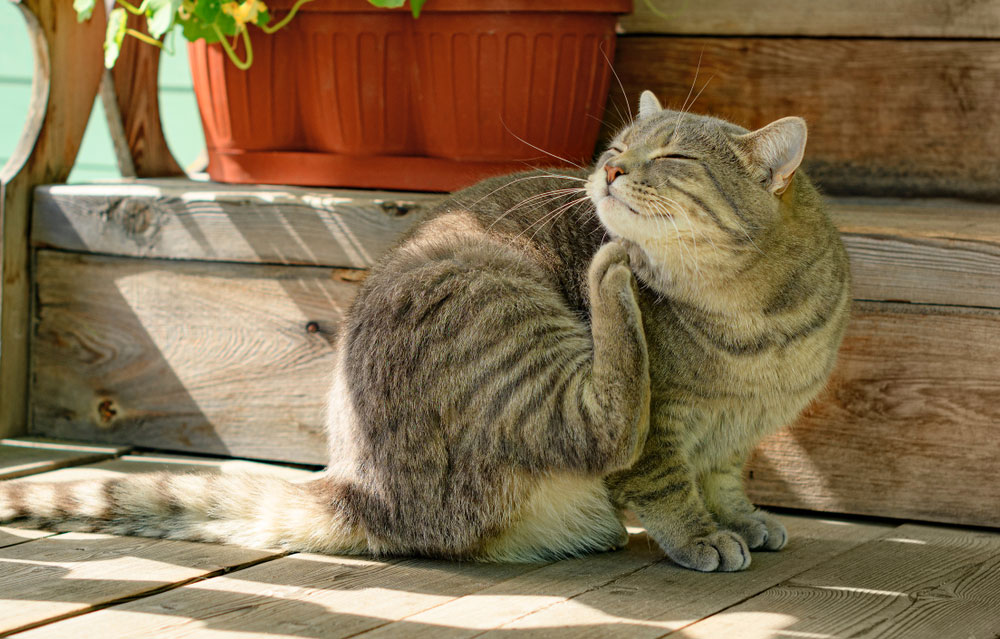Cat dandruff is a condition caused by dry, itchy skin. Many cats deal with this scratchy situation, which appears as white flakes of skin on the coat. Cat dandruff is often a result of dryness or dehydration, much like in humans. This unsightly condition may also point to a more serious problem that manifests on the skin.
At Union Lake Pet Services, we often get asked about skin and coat health, as well as cat dandruff. Read on to get to the root of this itchy problem.
What Causes Cat Dandruff?
Dandruff may seem like a small issue, but it can result in inflammation of the skin, loss of fur, and injury due to scratching. When your cat continues to scratch, any open wounds can become infected. It’s important to know the difference between the occasional flaky skin episode and more chronic, serious dryness.
So, what are the common causes of cat dandruff?
1. Parasites – Fleas, mites, and other external parasites cause damage to the health of your cat’s skin and coat. These parasites make life uncomfortable for your fur friend, but you can easily prevent them through a monthly parasite preventative. Inspect your cat often for signs of parasites and don’t hesitate to ask us about a good monthly parasite control for them, which is essential to their health.
2. Nutrition and diet – Many cats have undiagnosed food allergies which produce skin disorders, such as dandruff and inflammation. If your cat is showing signs of a food allergy, including scratching, biting at skin, diarrhea, vomiting, and other gastrointestinal problems, call your Union Lake team.
3. Dehydration – If your kitty is on a kibble-only diet, chances are, they aren’t getting enough moisture from their food source. Your fluffy one may not be drinking enough water. This is a problem for most cats because they are finicky about their drinking water. If your cat is on a dry diet, consider adding a bit of wet food to the mix or pouring tuna water over the kibble. Encourage your cat to drink more by switching to a fountain dispenser instead of a standard water bowl. You can also put a small amount of tuna water or wet food water into their drinking source to entice them.
4. Seasonal allergies – Spring and summer are the seasons for pollen. Cats also suffer from pollen or seasonal allergies. The only difference with them is that this condition primarily causes itchiness and skin disorders as the allergic reaction. Sometimes, your cat will also sneeze or cough and have watery eyes and discharge from the nose. Contact allergies can also wreak havoc on your cat’s skin. These allergens include laundry soap, shampoo, fabric softener, and chemically based products around the home.
5. Metabolic disorders/cancer – Diabetes, thyroid problems, and other metabolic disorders can result in dry skin and dandruff. While these diseases are a less probable cause of your cat’s dandruff, you should consult your veterinarian when you notice an increase in skin problems with your pet.
6 Tips for How to Get Rid of Cat Dandruff
Once your feline has a clean bill of medical health and the cat dandruff is nothing to worry about, what can you do to reduce these flakes?
- Make sure your cat is getting enough moisture in their diet and drinking plenty of water.
- Feed your cat a high quality diet and add a scoop of wet food to the mix, if they only eat dry food.
- Have your pet professionally groomed once every few months and bathe them biweekly if possible using a shampoo that developed for cats with dry skin (ask us for recommendations).
- Get a good grooming brush and use it to regularly brush your cat’s fur. This can help to distribute natural skin oils throughout your cat’s coat.
- Keep them on a monthly flea and tick medication.
- Switch to cat friendly cleaners and detergents that use plant based, nontoxic products
If your cat is scratching a lot or has dry, flaky skin, consult with us on next steps. We will assess the cause of the issue and offer several options to keep them itch-free.

